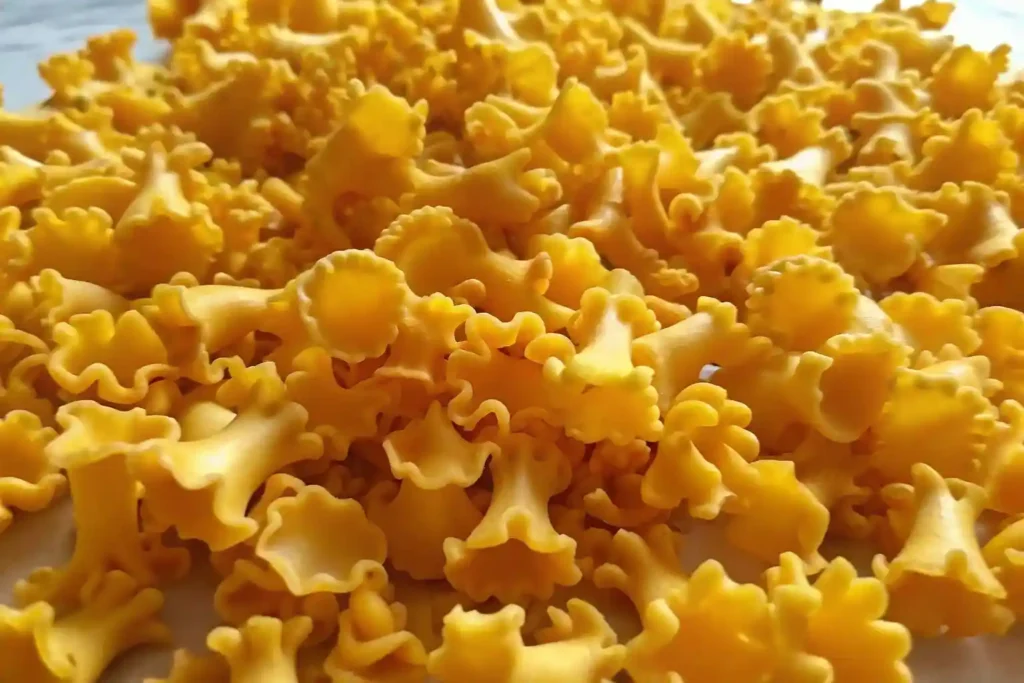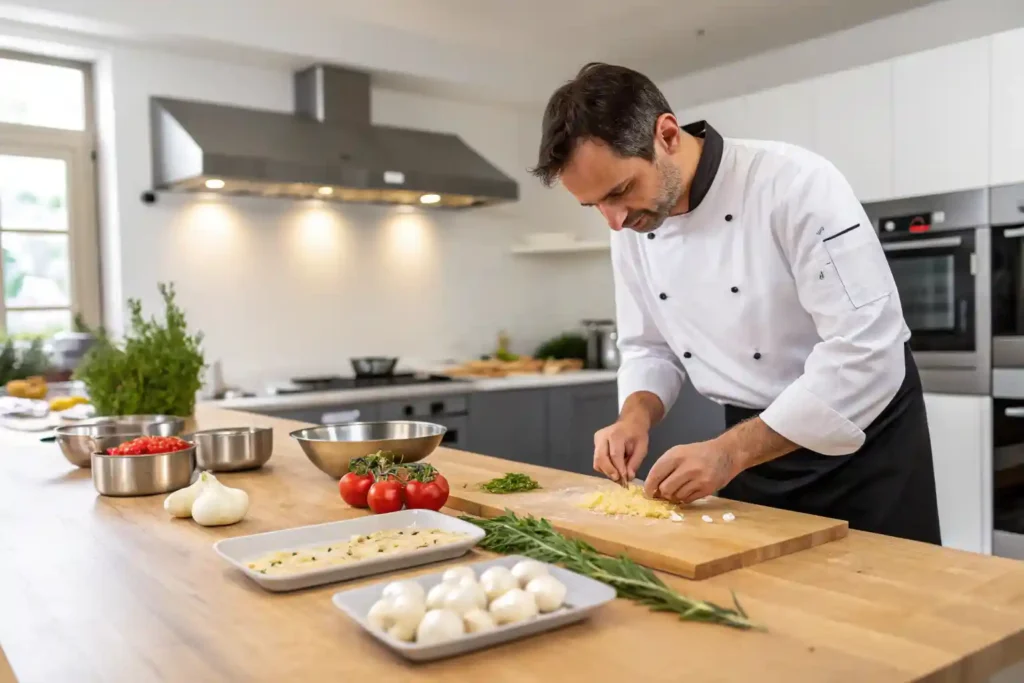Gigli pasta, with its unique shape and delightful texture, is a hidden gem in the world of Italian cuisine. In this article, we’ll explore everything you need to know about this pasta, from its origins and cooking techniques to delicious recipes and nutritional benefits. Whether you’re a seasoned chef or a home cook looking to spice up your meals, gigli pasta is sure to become a staple in your kitchen. So, let’s dive into the wonderful world of this pasta and discover why it deserves a spot on your dinner table!
Table of contents
1: Introduction to Gigli Pasta
What is Gigli Pasta?
Gigli pasta, often referred to as campanelle, is a charming Italian pasta shape that resembles small, fluted bells. Its name, “gigli,” means “lilies” in Italian, which perfectly captures its flower-like appearance. This pasta is typically made from durum wheat semolina, giving it a firm texture that holds up well in various dishes. Originating from the southern regions of Italy, this pasta has been a beloved choice for generations, thanks to its ability to capture sauces and flavors beautifully.
Why Choose Gigli Pasta?
So, why should you consider adding gigli pasta to your culinary repertoire? For starters, its unique shape isn’t just for show; it’s designed to hold onto sauces, making every bite a burst of flavor. Whether you’re tossing it with a rich tomato sauce, a creamy Alfredo, or a light pesto, this pasta elevates any dish. Plus, its versatility means it can be used in everything from hearty casseroles to refreshing salads.
2: The Unique Shape of Gigli Pasta

Characteristics of this pasta
Gigli pasta stands out not just for its taste but also for its distinctive shape. Resembling small, fluted bells, this pasta is about an inch long and has a ruffled edge. This unique design isn’t just for aesthetics; it plays a crucial role in how the pasta interacts with sauces. The fluted edges create little pockets that trap sauce, ensuring that every bite is packed with flavor.
When you compare gigli pasta to other shapes, like penne or fusilli, you’ll notice that gigli has a more delicate appearance. This makes it perfect for both elegant dishes and hearty meals. Plus, its shape allows it to hold up well during cooking, so you won’t end up with mushy pasta.
How the Shape Affects Cooking
The shape of gigli pasta also influences how you should cook it. Generally, it cooks in about 8 to 10 minutes, depending on the brand and thickness. To achieve that perfect al dente texture, be sure to follow the package instructions and taste it a minute or two before the suggested cooking time ends.
When it comes to pairing this pasta with sauces, its unique shape shines. It works wonderfully with chunky sauces, as the ridges catch bits of meat and vegetables. For a lighter option, try tossing it with a simple olive oil and garlic sauce, allowing the pasta’s flavor to take center stage.
In summary, the unique shape ofthis pasta not only makes it visually appealing but also enhances its culinary versatility. Now, let’s explore how to cook with this pasta in the next section!
3: Cooking with Gigli Pasta

Best Cooking Techniques for this pasta
Cooking gigli pasta is straightforward, but a few tips can help you achieve the best results. First, always use a large pot of salted water. The salt enhances the pasta’s flavor and helps it cook evenly. Once the water is boiling, add the this pasta and stir gently to prevent sticking.
As mentioned earlier, gigli typically cooks in about 8 to 10 minutes. To ensure it’s cooked perfectly, taste a piece a minute or two before the time is up. You want it to be tender but still firm to the bite, which is known as al dente. After draining the pasta, consider reserving a cup of the cooking water. This starchy water can be a great addition to your sauce, helping it cling to the pasta better.
Popular Gigli Pasta Recipes
Now that you know how to cook gigli pasta, let’s dive into some delicious recipes! One classic dish is this pasta with a rich tomato sauce. Start by sautéing garlic and onions in olive oil, then add crushed tomatoes, basil, and a pinch of sugar. Let it simmer while your pasta cooks, and then combine them for a comforting meal.
For a more modern twist, try gigli pasta in a creamy mushroom sauce. Sauté sliced mushrooms and garlic in butter, then add heavy cream and Parmesan cheese. Toss in the cooked this pasta and finish with fresh parsley for a delightful dish that’s sure to impress.
If you’re looking for something lighter, consider a gigli pasta salad. Combine cooked gigli with cherry tomatoes, mozzarella balls, fresh basil, and a drizzle of balsamic glaze. This refreshing dish is perfect for summer gatherings or as a side for grilled meats.
Pairing Gigli Pasta with Sauces
Traditional Sauces for Gigli Pasta
When it comes to pairing gigli pasta with sauces, the options are nearly endless. Traditional Italian sauces work beautifully with this unique pasta shape. One classic choice is a rich marinara sauce. To make it, simply sauté garlic and onions in olive oil, then add crushed tomatoes, a sprinkle of salt, and fresh basil. Let it simmer until thickened, and then toss in your cooked this pasta. The fluted edges of the pasta will catch the sauce, ensuring every bite is flavorful.
Another fantastic option is a creamy Alfredo sauce. Start by melting butter in a pan, then add heavy cream and grated Parmesan cheese. Stir until the cheese melts and the sauce thickens. Toss in the gigli pasta and finish with a sprinkle of black pepper and parsley. This dish is rich and comforting, perfect for a cozy dinner.
Innovative Sauce Ideas
If you’re feeling adventurous, try some innovative sauce ideas that complement gigli pasta. For instance, a lemon and garlic sauce can add a refreshing twist. Sauté minced garlic in olive oil, then add lemon juice and zest. Toss in the cooked this pasta along with some spinach or arugula for a light, vibrant dish.
Another exciting option is a roasted red pepper sauce. Blend roasted red peppers with garlic, olive oil, and a splash of cream for a smooth, flavorful sauce. This pairs wonderfully with gigli pasta, creating a dish that’s both colorful and delicious.
For more delicious recipes, check out our recipe article on Healthi Recipes. You’ll find plenty of ideas to inspire your cooking adventures!
In summary, gigli pasta’s unique shape makes it a perfect match for a variety of sauces, from traditional marinara to innovative lemon and garlic. Experimenting with different flavors can lead to delightful meals that impress your family and friends.
Nutritional Benefits of Gigli Pasta
Nutritional Profile
Gigli pasta isn’t just delicious; it also offers some nutritional benefits. Typically made from durum wheat semolina, it provides a good source of carbohydrates, which are essential for energy. A standard serving of cooked this pasta contains about 200 calories, making it a satisfying option for a meal.
In addition to carbs, gigli pasta contains some protein, usually around 7 grams per serving. This makes it a decent choice for those looking to include more protein in their diet. However, it’s important to balance your meal with vegetables, lean proteins, and healthy fats to create a well-rounded dish.
Health Benefits
One of the great things about gigli pasta is its versatility. You can easily find whole grain or gluten-free versions, catering to different dietary needs. Whole grain this pasta retains more fiber, which is beneficial for digestion and can help keep you feeling full longer.
Moreover, when paired with nutrient-rich sauces and ingredients, this pasta can be part of a healthy diet. For example, adding vegetables like spinach, tomatoes, or bell peppers not only enhances the flavor but also boosts the nutritional value of your meal.
6: Gigli Pasta in Italian Cuisine
Regional Variations
Gigli pasta is not just a one-size-fits-all ingredient; it has a special place in various regions of Italy. In the southern parts, particularly in Campania, this pasta is often used in hearty dishes that feature rich tomato sauces and fresh vegetables. For instance, you might find it in a classic pasta alla norma, which combines eggplant, tomatoes, and ricotta cheese. This dish highlights the pasta’s ability to hold onto the sauce, making every bite a delight.
In contrast, northern regions may use gigli pasta in cream-based sauces, reflecting the local preference for richer flavors. A popular dish might include gigli pasta tossed with a creamy gorgonzola sauce, topped with walnuts for added texture. This variation showcases how versatile gigli pasta can be, adapting to different culinary traditions across Italy.
Cultural Significance
Beyond its delicious taste, gigli pasta carries cultural significance in Italian cuisine. It’s often featured in family gatherings and festive meals, symbolizing togetherness and celebration. In many Italian households, preparing a meal with this pasta is a way to connect with family traditions and share stories around the dinner table.
Moreover, gigli pasta is sometimes used in special occasions, such as weddings or holidays, where its unique shape adds a festive touch to the meal. This pasta not only fills the stomach but also warms the heart, making it a beloved choice in Italian culture.
In summary, gigli pasta is deeply rooted in Italian culinary traditions, with regional variations that highlight its versatility. Whether in a simple family meal or a grand celebration, this pasta brings people together through its delightful flavors and textures.
7: FAQs About Gigli Pasta
What kind of pasta is gigli?
this pasta is a unique Italian pasta shape that resembles small, fluted bells. It’s made from durum wheat semolina, which gives it a firm texture that holds up well in various dishes. This pasta is perfect for capturing sauces, making it a favorite among home cooks and chefs alike.
How do you pronounce gigli pasta?
The pronunciation of this pasta is “JEE-lee.” The “g” is soft, similar to the “g” in “giant.” Knowing how to pronounce it can help you confidently order it at Italian restaurants or discuss it with friends.
What is the difference between gigli and campanelle?
While gigli and campanelle are often confused due to their similar shapes, there are subtle differences. Gigli pasta has a more pronounced fluted edge and is typically slightly shorter than campanelle. Both shapes are excellent for holding sauces, but gigli’s unique design makes it particularly good for capturing chunky ingredients.
What is another name for this pasta?
Gigli pasta is sometimes referred to as campanelle, especially in certain regions of Italy. However, it’s important to note that while they share similarities, they are distinct shapes. Regardless of the name, both types of pasta are delicious and versatile in the kitchen.
8: Conclusion
In conclusion, gigli pasta is a versatile and visually stunning option for any pasta lover. Its unique shape allows it to hold sauces exceptionally well, making it perfect for a variety of dishes. Whether you choose to prepare it with a rich, creamy sauce or a lighter option, this pasta can elevate your meal. For a delicious pairing, try our Burrata Pasta recipe, which highlights the pasta’s texture and flavor. Additionally, if you’re looking for healthier alternatives, our Skinny Pasta Guide offers great options to enjoy pasta guilt-free. Withthis pasta in your kitchen, the possibilities are endless, and you can create delightful meals that impress family and friends alike!
For those interested in exploring more about this delightful pasta shape, I recommend checking out the detailed information available at Share the Pasta. This resource provides insights into the history, characteristics, and various uses of gigli pasta, helping you to appreciate its role in Italian cuisine even more.

